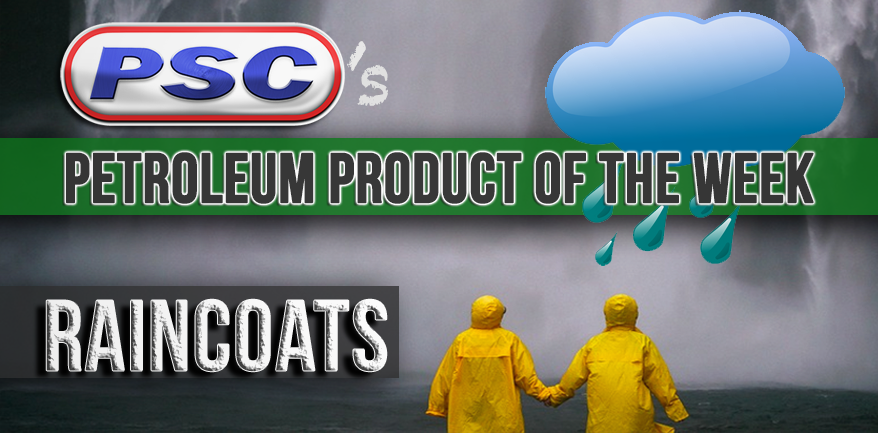April showers bring May Flowers…
When it rains it pours…
Rain, rain go away–come again when I have my raincoat…
When I think of the stereotypical raincoat, I immediately think of little Georgie from Stephen King’s It. Maybe you know the scene–sailing his newspaper boat, (“S.S. Georgie Mer Mer!”), little Georgie is happy in his little yellow raincoat and matching floppy rain hat until the boat is washed into the sewage drain and, well…nothing good happens after that.
On a positive note, though, at least his raincoat probably kept him nice and nice and dry despite the rain?
Late 80s/early 90s Stephen King pop culture aside, raincoats are an incredibly important piece of clothing. And while today they come in all shapes, sizes, colors, and materials and utilize new technology, they have been around for a very, very long time in some form or another.
History of Rainwear
Before things like nylon, polyester, and plastic zippers were invented, ancient peoples still managed to find ways to stay dry. The Inuits, for example, really needed to find ways to stay dry while spear hunting in the open ocean. Their methods are something that many of us might not have the guts to pull off today: literal guts. Whale and seal intestines proved to waterproof, yet air permeable–perfect for staying dry. They connected and sealed the seams with glue made from rendered bones.
As early as the 13th century, people in South America were using rubber extracted from rubber trees to waterproof their clothing and footwear. Grass and leaves were used in China (and potentially neolithic Europe, too) to waterproof hats and capes. For dryness and warmth, animal furs were used for their water resistant and insulating properties (think along the lines of lanolin, the wax secreted from sheep and other wool-bearing animals).
Waterproofing
By the 18th century, Europeans were experimenting ways to waterproof fabric for clothes. François Fresneau, a French botonist and scientist, wrote the first scientific paper on natural rubber and is credited with devising an early idea for waterproofing fabric in 1748 (by dipping in solutions of rubber with turpentine as solvent). In 1821, the first raincoat was manufactured by G. Fox of London called Fox’s Aquatic made from a fabric called gambroon.

Scottish chemist and chemical manufacturer Charles Macintosh is credited with having invented the first waterproof raincoat, following his patent for binding two pieces of material together with rubber dissolved in naphtha. Macintosh’s method was superior to any other rubber clothing because not only were the garments water and windproof, but they looked good and were soft and flexible.
The British military was Macintosh’s first customer. His findings led to more innovative uses for rubber, including tires (thank you, Charles Goodyear, and your process for vulcanizing rubber!).
Naturally, waterproof clothing innovation didn’t stop there. Macintosh’s coat design (called Mackintosh–spelling variation intended here) wasn’t breathable and wasn’t suited for outdoor mountaineering or war.
Burberry innovated a waterproof coat made from a material called Garbardine that was very light and breathable. The British Army contracted them to make some alterations for soldiers during WWI, and thus the trenchcoat was born.
Oil-treated fabrics became popular in the 1920s. In the 1930s, shorter jackets called car coats were invented for use riding in automobiles. After 1940, lighter rainwear became more popular. Post-war, petroleum-derived materials were much cheaper to produce, especially compared to wool. Vinyl was the waterproof material of choice in the 1950s, and plastic through the 70s, but these were problematic as they retained heat.
Modern Rainwear
Today, the number of raincoats available is beyond measure. Gabardine trenchcoats remain popular and natural and artificial blends, rubber and plastic are all still used today, too. Gore-Tex, a synthetic fabric made from plastic-coated artificial fibers, has been a popular material for raincoats since its invention in 1969, but it’s not the only option when it comes to a high-performance, breathable jacket.
Choosing a Jacket
If you’re in the market for a new raincoat, there’s good news and bad news. The good news is that you have so many options to choose from, so you can pick the perfect jacket for your needs. The bad news is that you have so many options to choose from that determining the right one for you can seem like an impossible task.
Don’t believe me?
Here are only a couple of things you can consider before your next purchase:

- Waterproof vs water-resistant
- Breathable or non-breathable
- Wind-proof or wind-resistant
- Hard shell or soft shell or hybrid shell
- Laminate or coating
- 2-layer, 2.5-layer, or 3-layer design
- Seam taping
- Zippers
- Vents
- Pockets
- Packability
…That’s not even all of it, frankly. To be fair, though, the average person might not need to consider all the factors if it’s just for casual don’t want to get soaked on the way to work wear. But knowing what you need, coupled with what you can afford, is a major indicator for what jacket is right for you. REI has a great write-up on how to choose rainwear and what all these options mean. And if you want to learn more about how rainwear actually works, they have a nice post on that, too.
I recently went out and purchased a new rainjacket, and sure enough, I felt incredibly overwhelmed.
I ended up going with a 2.5-layer, windproof, waterproof, breathable jacket made from recycled ripstop nylon, just in case you were wondering. With my luck, though, we’ll probably experience a drought now that I finally went out and bought one.
While you might have a lot of questions about raincoats, I think we can agree that this is the real question: do they float?
Sources:
https://en.wikipedia.org/wiki/Raincoat
http://www.madehow.com/Volume-6/Raincoat.html
http://gizmodo.com/the-history-of-rain-jacket-tech-from-intestines-to-gor-1684027896







